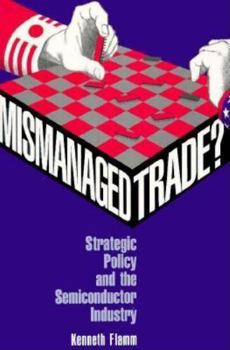Mismanaged Trade?: Strategic Policy and the Semiconductor Industry
Select Format
Select Condition 
Book Overview
" The semiconductor industry is at the forefront of current tensions over international trade and investment in high technology industries. This book traces the struggle between U.S. and Japanese semiconductor producers from its origins in the 1950s to the novel experiment with ""managed trade"" embodied in the U.S.-Japan Semiconductor Trade Arrangements of 1986, and the current debate over continuation of elements of that agreement. Flamm provides...
Format:Paperback
Language:English
ISBN:0815728476
ISBN13:9780815728474
Release Date:June 1996
Publisher:Brookings Institution Press
Length:494 Pages
Weight:1.50 lbs.
Dimensions:1.3" x 6.0" x 9.1"
Related Subjects
Business Business & Investing Economics Political Science Politics & Social SciencesCustomer Reviews
2 ratings
Mismanaged Trade by Kenneth Flamm
Published by Thriftbooks.com User , 21 years ago
Ken Flamm is an economist and senior fellow in the Foreign Policy studies program at the Brookings Institution. In the late 1980s, Flamm published two highly influential books on the role of the governments of advanced industrial nations in the development of the computer industry -- Targeting the Computer (1987) and Creating the Computer (1988). In these books, he provided evidence against the arguments of authors like George Gilder and industrialists like T.J. Rodgers of Cypress Semiconductors that the role of government in creating the computer industry and other high technology industries in the United States was negligible. Flamm argues in this long but ultimately rewarding book that it was only after the development of large-scale integrated circuits in the United States took the fledgling Japanese computer industry by surprise in the early 1970s that the Japanese government and industry focused on developing indigenous technologies for semiconductors. A series of joint government-industry projects succeeded by the end of the 1970s in enabling the Japanese semiconductor industry, or at least the part of it that produced DRAMs (dynamic random access memories), to become fully competitive with the U.S. industry. Since demand for integrated circuits was rapidly expanding in the late 1970s and early 1980s, the U.S. semiconductor industry was willing to share the market with Japanese producers. Beginning in 1984, however, a sharp downturn in demand for semiconductors resulted in a shakeout in the industry, but only U.S. firms left the market while Japanese producers kept producing and selling at substantially lower prices. This led to the filing of anti-dumping petitions on the part of U.S. producers, upon which the Department of Commerce and the International Trade Commission ruled favorably in 1985 and 1986. Flamm claims, however, that Japanese pricing during this period could be explained as "a predictable outcome of normal market forces" (p. 428) and that U.S. antidumping laws were not designed -- as they should have been -- to take forward pricing behavior into account. Forward pricing is pricing below average costs in the short term so that demand for a firm's products will allow it to increase production in the long term, eventually reducing average costs so that they are below market prices. Forward pricing is rational for industries that have steep learning curves: that is, where average costs descend rapidly with cumulative production.Successful antidumping petitions filed by U.S. firms against Japanese firms led to a major trade dispute and eventually to a negotiated settlement in the form of the Semiconductor Trade Arrangement (STA) of 1986. Under the STA, Japanese firms agreed to a system of floor prices for sales of their semiconductors in the United States and third-country markets, the Japanese government agreed to collect statistics on semiconductor production costs and prices, and the Japanese market was pledged to inc
a trip down memory lane
Published by Thriftbooks.com User , 23 years ago
This is a highly detailed account of US trade policy toward the semiconductor industry, most of which involved Japan, America's primary competitor in this industry during the 1980s. The book draws on extensive secondary source materials (mostly industry publications) and interviews conducted by the author. Flamm is not shy about criticizing the work of others with whom he disagrees (Laura Tyson and David Yoffie, for example), but oddly fails to cite others whose parallel analyses predate this book (i.e. Andrew Dick on forward pricing strategies or Fred Bergsten and Marcus Noland on the quantitative impact of the semiconductor trade agreement).






